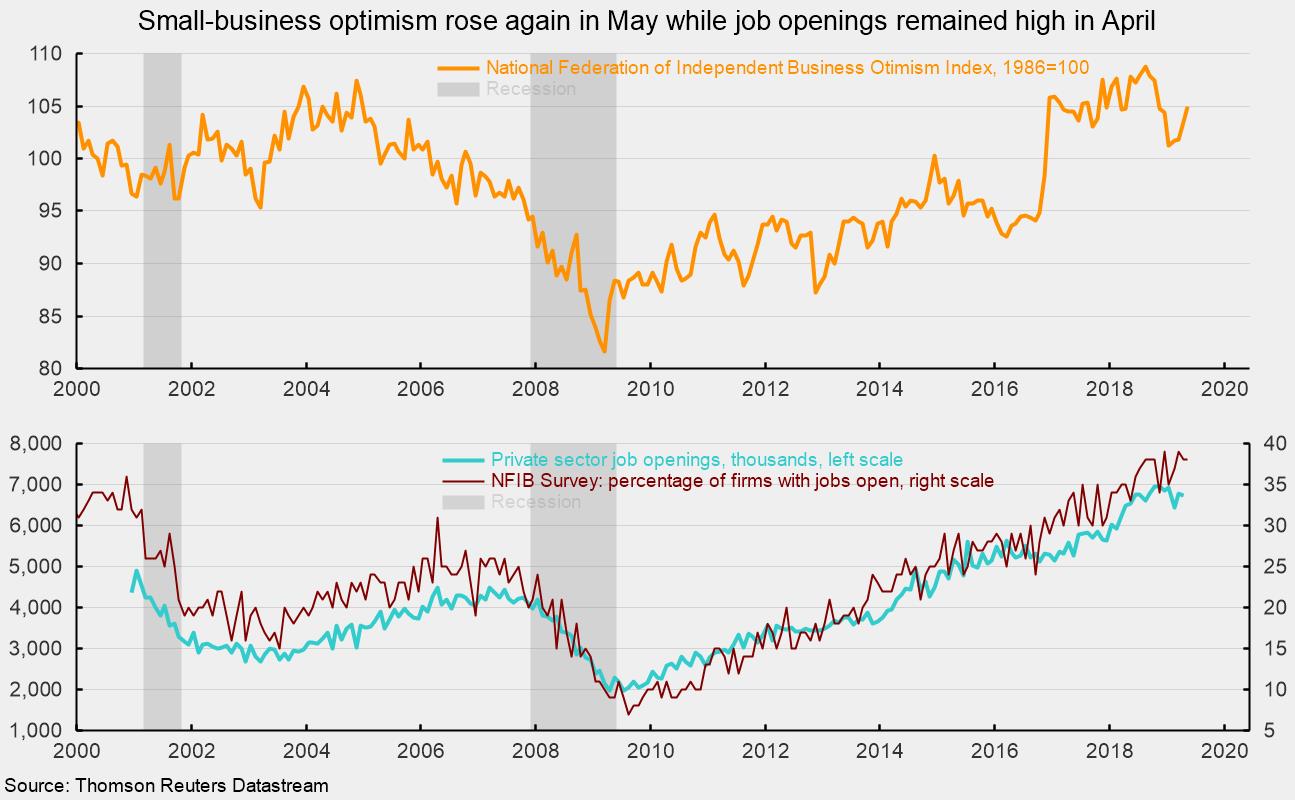Small-Business Confidence Remains Strong Amid a Tight Labor Market
The small-business-optimism index from the National Federation of Independent Business rose to 105.0 in May, up 1.5 points from 103.5 in April and 3.8 points below the all-time high of 108.8 in August 2018. The latest result extends a run of 30 consecutive months above 100, a very high figure by historical comparison (see top chart). The strong result was buoyed by positive results for capital spending, hiring, inventory investment, and profit trends. The single most important problem among small businesses remains the declining quality of the available labor force, particularly in the context of an already-tight labor market and the very high percentage of firms with open jobs.
The general outlook remained positive as the percentage of respondents believing now is a good time to expand came in at 30, up from 25 in April. The net percentage of respondents expecting better economic conditions (“better” minus “worse”) came in at 16, up from 13 in April but still high compared to negative numbers from 2016. A net 23 percent expect higher sales over the coming months while a net 9 percent report higher sales for the most recent three months versus the prior three months.
The percentage of firms planning to increase employment rose to 21 percent from 20 percent in April. A near-record 38 percent (versus a record 39 percent) of firms report having openings they are not able to fill at the moment (see chart). At the same time, the percentage of firms reporting few or no qualified applicants for job openings was 54 percent, up from 49 percent in April and just 1 point below the record 55 percent from June 2018. That combination in the labor market of healthy demand and weak supply has a net 34 percent of firms saying they have already increased compensation over the past three months while 24 percent intend to increase worker pay over the coming months.
The labor-market dynamics have made quality of labor the most important issue for small businesses. Among the 10 issues listed in the survey, quality of labor ranks first at 25 percent, tying the survey high. Taxes were second at 16 percent while government regulation and red tape was third on the list at 12 percent. Inflation was at the bottom of the list, tied with finance and interest rates at just 2 percent. Inflation has been at the bottom of the list for several years, reflecting the slow pace of price increases over the current cycle.
Capital expenditures by small businesses also remain solid, with 64 percent of such businesses having made capital expenditures during the past six months. That is slightly below the typical percentage in the upper 60s during the late 1990s but well above the mid-40s percentages during the last recession. Thirty percent of firms have plans for capital expenditures over the next three to six months, up from 27 percent in the prior month.
Overall, the survey suggests the small-business sector of the economy remains strong and views of the future remain upbeat.
The latest Job Openings and Labor Turnover Survey from the Bureau of Labor Statistics shows the number of open positions in the economy was down slightly in April to 7.449 million from 7.474 million in March and just below the record-high 7.626 million in November. Private job openings in the United States totaled 6.726 million in April versus 6.772 million in March. The industries with the largest number of openings were health care (1.244 million), professional and business services (1.241 million), accommodation and food services (899,000), and retail (837,000).
The job-openings rate, openings divided by the sum of jobs and openings, held at 5.0 percent for the private sector. That is just 0.2 percentage points below the all-time high of 5.2 percent. The highest openings rates were in accommodation and food services (5.9 percent), health care (5.8 percent), and transportation, warehousing, and utilities (5.8 percent).
A further sign of labor-market strength may be seen in the number of quits, which likely reflects confidence in the labor market. Quits totaled 3.300 million for the private sector in April versus 3.278 million in March. The layoffs rate, another key indicator for the labor market, rose slightly to 1.3 percent for private employers from 1.2 percent in the prior month and is consistent with the historically low initial claims as a percentage of employment. Combined, the high number of openings, the high openings rate, and the low layoffs rate all suggest the labor market remains very tight.
Overall, the data relating to the labor market continue to show strength. Despite a disappointing jobs report for May, job openings and quits remain high while layoffs remain low, supporting a high level of consumer sentiment.






